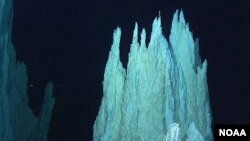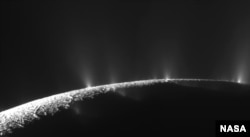Scientists are one step closer to answering the eternal question of how life began on Earth.
Three new studies co-authored by Mike Russell, a research scientist in planetary chemistry and astrobiology at the NASA Jet Propulsion Laboratory, strengthen the theory that life on Earth began at alkaline thermal vents at the bottom of the ocean.
In fact, the theory can be tested in the real world at the so-called “Lost City” alkaline thermal vents at the bottom of the North Atlantic Ocean.There, researchers have found strong evidence to back up Russell’s claims.
"Our work on alkaline hot springs on the ocean floor makes what we believe is the most plausible case for the origin of the life's building blocks and its energy supply," Russell said in a statement. "Our hypothesis is testable, has the right assortment of ingredients and obeys the laws of thermodynamics."
In papers published in the journal Philosophical Transactions of the Royal Society B, Russell provides more details on the chemical and metabolic reactions that have to take place in order for life to emerge.
According to Russell, about four billion years ago, during Earth’s “Hadean” age, these same reactions took place on the ancient ocean floor. Specifically, the fluids from the undersea vents mixed with ocean waters to create acetate, which is comparable to vinegar. Acetate is a product of methane and hydrogen from the vents and dissolved carbon dioxide in the water. Acetate could become the basis of other biological molecules, according to Russell.
Russell and his co-authors also describe how organic carbon and polymers, which would have been the energy sources for the first cells, could have been created from inorganic minerals.
In another paper published in the journal Biochimica et Biophysica Acta, researchers describe the structural similarity between the most ancient enzymes of life and minerals found near vents.
The research has implications for the possibility of finding life on other worlds.
For example, Jupiter’s moon Europa and Saturn’s moon Enceladus are icy worlds with subsurface, liquid oceans. If there are alkaline thermal vents on the ocean floors of those moons, scientists will know what chemical signatures to look for as an indication of potential life.
Three new studies co-authored by Mike Russell, a research scientist in planetary chemistry and astrobiology at the NASA Jet Propulsion Laboratory, strengthen the theory that life on Earth began at alkaline thermal vents at the bottom of the ocean.
In fact, the theory can be tested in the real world at the so-called “Lost City” alkaline thermal vents at the bottom of the North Atlantic Ocean.There, researchers have found strong evidence to back up Russell’s claims.
"Our work on alkaline hot springs on the ocean floor makes what we believe is the most plausible case for the origin of the life's building blocks and its energy supply," Russell said in a statement. "Our hypothesis is testable, has the right assortment of ingredients and obeys the laws of thermodynamics."
In papers published in the journal Philosophical Transactions of the Royal Society B, Russell provides more details on the chemical and metabolic reactions that have to take place in order for life to emerge.
According to Russell, about four billion years ago, during Earth’s “Hadean” age, these same reactions took place on the ancient ocean floor. Specifically, the fluids from the undersea vents mixed with ocean waters to create acetate, which is comparable to vinegar. Acetate is a product of methane and hydrogen from the vents and dissolved carbon dioxide in the water. Acetate could become the basis of other biological molecules, according to Russell.
Russell and his co-authors also describe how organic carbon and polymers, which would have been the energy sources for the first cells, could have been created from inorganic minerals.
In another paper published in the journal Biochimica et Biophysica Acta, researchers describe the structural similarity between the most ancient enzymes of life and minerals found near vents.
The research has implications for the possibility of finding life on other worlds.
For example, Jupiter’s moon Europa and Saturn’s moon Enceladus are icy worlds with subsurface, liquid oceans. If there are alkaline thermal vents on the ocean floors of those moons, scientists will know what chemical signatures to look for as an indication of potential life.









